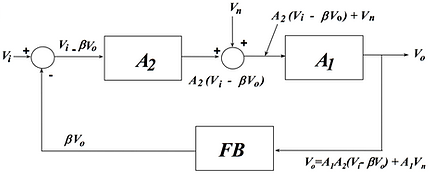Gain De-sensitivity
The negative reduces the change in the closed-loop gain due to open-loop gain variation
dAf / Af = Sensitivity of the close loop gain, reduced by (1+Aβ)
dA / A = Sensitivity of the open loop gain, bigger
A - Very Large
β - small
∴ Aβ >> 1, large
∴1/(1+Aβ) is small
The desensitivity factor is (1+Aβ), which is the amount of feedback
Bandwidth Extension
A(s) = AmFL(s)
Consider FL(S) being characterised by a dominant pole, 𝛚L and a zero at 0
The closed-loop gain is:
Negative feedback:
Reduces the gain by a factor of (1+Am𝜷)
lower 3dB frequency
⇒Low Frequency Response
Noise Reduction




A(s) = AmFH(s)
Consider FH(S) being characterised by a dominant pole
The closed-loop gain is:
Negative feedback:
Increases the gain by a factor of (1+Am𝜷)
upper 3dB frequency
⇒High Frequency Response



Noise reduction by negative feedback is possible with the above special
configuration.
Where A1 is a noisy amplifier and A2 is a noise‐free amplifier
Output, Vo = A1A2(Vi ‐ 𝛽Vo) + A1Vn:
Signal-to-Noise Ratio at output:
improved by A2 with negative feedback



Non-linear Distortion Reduction
Curve shoes the transfer characteristic of an amplifier. As indicated, the characteristic is piecewise linear, with the voltage gain changing from 1000 to 100 and then to 0. This nonlinear transfer characteristic will result in this amplifier generating a large amount of nonlinear distortion.
The amplifier transfer characteristic can be considerably linearized (i.e. made less non-linear) through the application of negative feedback. That this is possible should not be too surprising, since we have already seen that negative feedback reduces the dependence of the overall closed-loop amplifier gain on the open-loop gain of the basic amplifier. Thus large changes in open-loop gain (1000 to 100 in this case) give rise to mush smaller corresponding changes in the closed-loop gain.
To illustrate, let us apply negative feedback with 𝛽 = 0.01 to the amplifier whose open-loop voltage transfer chracteristic and the resulting transfer characteristic of the closed-loop amplifier are depicted in chart.
The slope of the steepest segment is given by
and the slope of the next segment is given by





